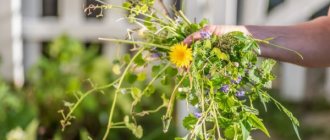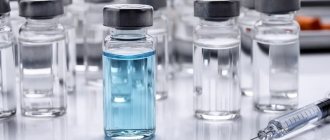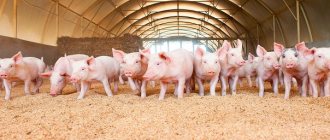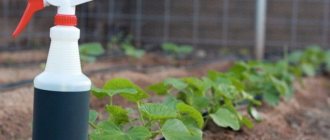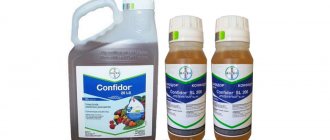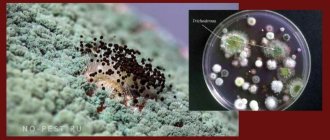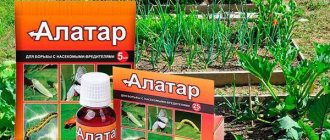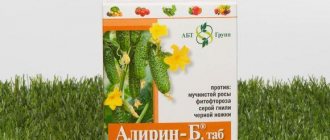Purpose and general characteristics
“Lepidotsid” translated into Russian means “destroying caterpillars.” Its main purpose is to fight caterpillars and false caterpillars. By its effect on organisms it is classified as an insecticidal preparation, by its method of penetration it is classified as an intestinal pesticide, and by its origin it is classified as a biological insecticide.
Cabbage white caterpillars
The range of effects on insects is wide, this includes most gnawing insects:
- codling moths,
- whites,
- scoops,
- moths,
- aphids,
- fruit moths,
- silkworms,
- trees,
- sawflies,
- fire,
- leaf rollers.
What is this insect?
To know who you have to fight with, you need to read the description of the pest, it will help to destroy it in a timely manner. Having detected the presence of an insect by certain signs.
The potato moth is a small butterfly. It is very inconspicuous and dangerous, and can destroy up to 80% of the crop.
Pest characteristics:
- Scientific name: Fluorimea.
- Size – 6–8 mm in length, 12–13 mm wingspan.
- The color is inconspicuous gray, with small black dots on the wings. When the insect folds them, the dots form dark stripes.
- The antennae are long.
- The mouthparts are small.
Mechanism of action
Bacteria enter the body of an insect (caterpillar) through food. Initially, fermentation enzymes begin to work, which ferment the nutrients eaten by the insect (glucose, ribose, fructose, maltose, starch, etc.) and form toxic substances. Further, through sporulation, a new colony of bacteria arises, which actively develops in the gastrointestinal tract. Bacteria live on oxygen consumed through a thin chitinous film. During their life, bacteria begin to actively secrete protease enzymes, which disrupt the structure of proteins and substances that cause β-hemolysis of hemolymph (a fluid that replaces blood in insects). Thus, the insect begins to internally “bleed” and the insect dies.
Leaf roller caterpillar (left) and sawfly caterpillar (right)
Varieties and formulation
The biological product is produced by various Russian manufacturers, but the main component is produced by Sibbiopharm LLC, the largest enterprise for the production of biological plant protection products from diseases and pests.
"Lepidotsid" is produced in the form of a concentrate in dry and liquid form:
a) “Lepidocid, P” is produced in powder form, packaged in sealed packaging for agricultural production in 10 kg, 15 kg, 20 kg. and for private household plots 10g, 20g, 50g, 100g. The convenience of this form lies in the long shelf life of up to 1.5 years, which reduces bacterial activity. When preparing the working stock solution, the activity of bacteria increases, maximum activity is observed after 1-3 days.
Examples of the biological product “Lepidocid” in powder form
b) “Lepidocid, SK” is produced in the form of a suspension concentrate, packaged for agricultural production in canisters of 5 liters or more. up to 20 l. and bottles of 1 liter, for personal households from 5 ml. in ampoules and 20 ml, 35 ml. in bottles. When preparing the working solution, it is recommended to add green soap or other adhesive to the composition.
c) “Lepidocid, SK-M” - a modified version of the suspension concentrate. The manufacturer does not specify what the innovation is, perhaps in the production of Bacillus thuringiensis serotype IV.
Examples of the biological product “Lepidocid” in the form of a suspension concentrate
Biological products to fight diseases
Planriz - created based on the bacterium Pseudomonas fluorescens. A simple production technology made it possible to obtain the drug in a small-scale manner at plant protection stations (branches of the Federal State Institution "Rosselkhoztsentr"). Widely used on cabbage to combat bacterial diseases, where chemical fungicides are not allowed. Used for pre-sowing treatment of grain seeds (0.5 l/ha) with low contamination with phytopathogens, for treatment of potato tubers and spraying during the growing season. The drug has a growth-stimulating effect. Can be used in integrated plant protection, in a system of alternating chemical and biological agents.
In the regions, this drug is most often produced by former plant protection stations (now branches of the Federal State Institution "Rosselkhoztsentr")
Fitosporin. A broad-spectrum drug based on Bacillus subtilis. It is used on grains, vegetables and potatoes, for processing fruit and berry plants, in protected soil. The effect of the drug is enhanced when used together with a humic-containing drug (gumi). When processing plants and fruits, they are covered with a black mesh of the drug, which prevents the penetration of phytopathogens for a long time. For example, tomatoes treated once in mid-July 2009 against late blight, collected at the end of August, ripened at home with virtually no waste. The preparation of the working fluid should be carried out according to the method recommended for BTB-202, lepidocide.
Binoram. The drug contains two types of bacteria that are active against plant diseases and has a strong growth-stimulating effect. It is increasingly used on grains, vegetables and potatoes for seed treatment and spraying during the growing season. In private farms and gardens, it is recommended for treating potatoes in the fight against rhizoctonia. The consumption rate is 7.5 ml per 10 liters of water. This amount can be used to treat 10 kg of potato tubers before planting. Produced by Alsiko-Agroprom LLC (Moscow).
Baktofit. It is used in open and closed ground to combat root rot, powdery mildew, late blight, rhizoctonia, blackleg, fusarium, bacteriosis on vegetables, roses, and carnations. Watering is carried out at the root with a 0.2-0.3% solution, spraying the plants with a 0.5-1.0% solution. In private farms it is used to protect cucumbers from root rot by soaking the seeds in a 0.2% working solution for 3-6 hours.
Glyocladin. A biological product based on a fungus from the genus Gliocladium, which has a strong antagonistic effect on phytopathogens. Designed to combat root rot. The drug is especially effective on cucumber.
Alirin, Gamair. Refers to the latest developments of VIZR. The drugs are produced at Agrobiotechnology LLC (Moscow). Recommended for wide use in open and closed ground. Taking into account the low consumption rates of the drug when treating seeds and when spraying vegetative plants, the convenient formulation that ensures manufacturability of application, the drugs began to be in demand by large joint stock companies, farmers, and owners of private farms. The drugs are available for retail sale. They are used according to the instructions.
The use of biological products for disease control differs from pest control tactics. They are usually used prophylactically or at the first signs of the onset of the disease.
Sergey Dobrokhotov, Candidate of Agricultural Sciences, St. Petersburg State Agrarian University, Department of Biological Plant Protection
Processing regulations
The working solution is prepared by adding the concentrate with continuous stirring, the dose is introduced gradually, it is allowed to vary the dosage. If the solution is prepared from a dry concentrate, it is recommended to “infuse” the mother solution before spraying so that the bacterial spores start the vital activity mechanism. It is advisable to add any adhesive to the composition.
Article on the topic: Insecticide Karate Zeon: instructions for use of the drug, storage, compatibility
It is recommended to carry out treatment in the morning, in dry and not windy weather.
It is important not to delay the treatment, but to carry it out immediately when small caterpillars (outwardly similar to worms) are detected, before they begin to bite into the fruit.
Drug Lepidocid
"Lepidotsid" is an insecticidal preparation of a biological type with intestinal action. This remedy is effective against leaf-eating parasites.
The solution has a selective effect due to the specific structure of the pests’ intestines. The substance contains crystals and spores of microbes and biological substances (products of bacterial activity).
The biological product was created to protect plants from the following insects: moth, silkworm, nun moth, leaf roller, meadow moth, white butterfly, moth and other pests.
The product is approved for use in forest areas and in households, in private plots and for urban plantings.
Vegetables
“Lepidotsid” is often used against potato moths, as well as caterpillars of lepidopteran insects. These are cabbage and turnip moths, and the moth - terrible pests of the garden and vegetable garden that can leave you without a harvest if measures are not taken in time. Since several generations of pests can be born over the summer, a number of treatments are required. The consumption of the drug is small - only 0.5 liters per 100 liters of water. Each new generation of pests is born at intervals of 7-8 days, so it is recommended to repeat the treatment every week. The consumption of the working solution is 200-400 liters per hectare. This insecticide very effectively protects crops of sugar beets, carrots and cabbage from meadow moth caterpillars.
Form, composition
The insecticide Lepidocide is available in 3 formulations:
Powder
Previous designation D – dust: strain BA-3000 EA/mg, titer of at least 60 billion spores/g. Packaging from the primary manufacturer in multi-layer sealed bags of 10.15 and 20 kg.
Storage temperature before opening the package is from –30 to +30 degrees Celsius, i.e. Lepidocid P can be stored frozen. Shelf life up to 18 months. The cost of 1 kg of the drug wholesale is approx. 600 rub.
Despite the higher content of the active principle, Lepidocid P is no more active than other preparative forms, because A significant proportion of bacteria do not develop from spores when using the drug.
The activity of the drug begins to appear after 1-3 days of its use. To prepare the working fluid, you must first prepare a mother solution (see below).
In general, Lepidocid P is a drug for the northern regions of growing target crops, where pest activity is lower.
SK (Suspension concentrate)
Strain BA-2000 EA/mg, titer no less than 10 billion spores/g. Primary packaging in PE canisters from 20 to 50 (typical – 28 l canisters).
Shelf life up to 12 months. at temperatures from +5 to +30 degrees. Wholesale price approx. 210 rub./l in terms of a 28 liter canister. The activity of the drug manifests itself during daylight hours.
The working solution can be prepared directly in the sprayer tank. Add approx. to the finished working fluid. 20 ml/l of any adhesive for agrochemicals or liquid household chemically neutral detergent (shampoo, etc.).
In terms of its set of qualities, it is a more “southern” drug for regions where there is a high probability of a sudden mass invasion of pests.
SK-M (Modified suspension concentrate)
All basic data is the same, but the wholesale price is approx. 250 rub./l per canister. Manufacturers, their contractors and distributors do not specify what the modification is.
If you added an adhesive to the concentrate, it becomes a bit expensive.
It is possible that the following serotype of bacteria was used, but the cultivation and mass production of serotype IV Bacillus thuringiensis var. kurstaki also cannot find reliable information.
Instructions for use
The stock solution of Lepidocide P is prepared with continuous stirring for approx. in half a liter of lukewarm water; the dose of the drug is administered gradually.
After preparing the solution, it should be allowed to stand for 10-15 minutes so that the spores “wake up” and become more active, and only then should it be introduced into the tank.
The working suspension of Lepidocide SK and SK-M is prepared directly in the tank of the device. Don't forget to add adhesive!
It is advisable to carry out the treatment on dry plants in the morning: at night the pests do not feed and a significant proportion of the bacteria will be wasted. Control of consumption during manual spraying - over the area, until a continuous film of the drug is formed, but without dripping drops.
Time before rain – 48 hours.
Apple trees need to be treated especially carefully against codling moths: spraying should be carried out when small “worms” (stray caterpillars) crawl on the leaves and fruits.
If they have already begun to bite into it, a good share of the harvest will still be lost.
Instructions for use (and how to dilute) the bioinsecticide Lepidocide in a private plot are given in the table: (click to enlarge)
Note: Lepidocide for use in private household plots on edible nightshades (potatoes, tomatoes, vegetable (sweet) peppers, eggplants) is not registered, but there are no fundamental contraindications to this, and private gardeners successfully use the drug, for example, on peppers.
Related article: Confidor Extra: instructions for use, reviews, storage of the drug
In the next table. Instructions for the use of Lepidocide in professional commercial agricultural farms are provided:
- powder (20g) - from 30 rubles;
- suspension concentrate (10l) - from 450 rubles;
Reviews
According to customer reviews, the advantages of the drug include:
- Acts selectively against a wide range of harmful Lepidoptera.
- Does not have phytotoxicity.
- Does not accumulate in plants and fruits.
- Guarantees an environmentally friendly, healthy harvest.
- Can be used at any stage of plant development.
- The waiting period is 5 days, which allows processing shortly before harvest.
- It is used when harmful insects are resistant to other chemical pesticides.
- When used at recommended consumption rates, it is safe for humans, warm-blooded animals, fish, aquatic organisms, bees and entomophages.
- Belongs to the 4th hazard class.
The disadvantages of Lepidocide are also due to its biological nature:
- Does not have translaminar and systemic activity, because it occurs at the molecular level;
- It acts on objects of elimination only by the intestinal route;
- It acts rather slowly - the caterpillars stop feeding and die within 2-3 days;
- Does not affect adults (reproducing and migrating generation) of pests);
- It is also ineffective against the larvae of Coleoptera, Diptera and other taxonomic groups - Bacillus thuringiensis is a specific pathogen of lepidoptera and certain species of lacewings;
- Useless against sucking pests, only affects gnawing ones;
- It is quite effective only against immature caterpillars and younger false caterpillars, or against small tender caterpillars;
- Secretive caterpillars (codling moths, tree moths) are attacked by the youngest ones only during the wandering phase, when they are still crawling around the plant, “testing their teeth” where it would be more convenient to bite deep;
- Does not destroy elimination objects 100%, i.e. more than one application per season is required;
- The drug emits an unpleasant and rather persistent odor, which, however, is not transmitted to agricultural products (subject to a waiting period);
- When using biological products and pesticides on the same farm, separate storage facilities must be installed for them.
Disadvantages of the product
The main disadvantages of this bioinsecticide include:
- the product is active only at the molecular level;
- Lepidocide affects pests slowly - their death occurs a few days after treatment;
- affects caterpillars of a younger age - only up to 3, but cannot cope with adults (insects of an adult level of development);
- the drug Lepidocid is effective only against gnawing pests, and is useless against sucking “harmful” bugs;
- the product should be used repeatedly during the summer season.
Precautionary measures
Security zones for working with the insecticide Lepidocide are established as follows:
- Apiary – 1.5 km (limit the flight of bees to 48 hours).
- Reservoirs, open sources of water supply - according to their water protection zone.
- Children's, medical and recreational institutions, sports grounds, public recreation areas - 150 m.
- Residential buildings, food storage facilities, premises and areas for keeping pets - 15 m.
- Other outbuildings – 5 m.
It is permissible to use minimal PPE for working with the drug: work clothes and shoes that completely cover the body, protective gloves.
When treating trees with a boom sprayer, it is highly advisable to wear safety glasses and a gauze bandage or a simple anti-dust petal respirator.
If you work with an injection sprayer, then it is better to wear waterproof overalls or put a plastic raincoat over your clothes.
The fact is that the unpleasant odor of the drug is quite persistent. If clothes become saturated with it, they will have to be aired in the sun for several days, and still, the smell will be felt for a long time.
If the drug gets on the body, it should be washed off and washed; Wash clothes wet with working fluid.
In case of contact with eyes, rinse them with water. If ingested, drink 2-4 glasses of water, induce vomiting and take 3-4 tablets of activated carbon.
Acute drug poisoning is unlikely and results in indigestion.
Theoretically, in case of poisoning with Lepidocide and other drugs containing Bacillus thuringiensis, phenomena similar to the effect of the venom of viper snakes are possible:
- skin ulceration;
- hematomas;
- internal hemorrhages;
- accompanied by severe sharp or nagging pain, but it is impossible to swallow the amount of drug required for this - long before it will turn inside out.
However, you must follow the general safety rule when working with pesticides - if you feel any discomfort, you should immediately stop working and consult a doctor.
Related article: Use of activated carbon on seedlings, in soil and during cuttings
Security measures
- But despite the low level of toxicity of the drug, safety precautions must be observed when working with it: treat plants in protective clothing, goggles, a mask, gloves and boots.
- Do not prepare the working solution in a container that you will subsequently use for food products.
- Do not drink, eat or smoke during the procedure.
- When you finish spraying, take a shower and rinse your mouth, and wash and wash your clothes and accessories.
DO NOT SELF-medicate! In case of drug poisoning, consult a doctor!
Analogs
Other contact or intestinal insecticides are similar to Lepidocide. The active substance of this type of drug is bacteria and their metabolic products.
In terms of efficiency, they are all approximately at the same level.
The impact on pests begins at the same time - 2-3 days. The difference lies in the number of insect species targeted.
Fitoverm
Contact insecticide. The actinomycete fungus produces a substance called avermectin, which has a destructive effect on the nervous system of insects, killing them. In addition to caterpillars, this drug is effective against aphids and spider mites.
It can be used to treat not only plants in the garden, but also delicate house plants.
However, when purchasing this biological product, you need to take into account that it has a toxic modification Bij, which tends to accumulate in fruits. You need to pay attention to this when purchasing.
Bitoxibacillin
It also fights pests thanks to bacteria that act on the gastrointestinal tract of insects and their reproductive system, preventing reproduction.
The drug has proven itself excellent in the fight not only against caterpillars, but also against Colorado potato beetles. True, it affects the latter somewhat more slowly.
But the period of active protective action reaches 20 days. Moreover, the drug is more toxic than Lepidocide and belongs to the third moderately dangerous class of substance.
There are other enteric-contact insecticides. They have a wider spectrum of action, they protect not only from lepidopteran insect larvae, but also from various types of mites, beetles and aphids.
Their common significant disadvantage in comparison with Lepidocide is their greater toxicity.
For example, Akarin was discontinued in 2021 due to its dangerous effects on bees. Since the validity period of this product is quite long, it can still sometimes be found in stores.
Short description
Chemicals in our garden plot are a common way to protect ourselves from various pests. But how safe is it? After all, the collected fruits are often eaten even without heat treatment. There is no clear answer today. In most cases, agricultural technicians agree that if the treatment is carried out on time, the risk to your health will be minimal. At the same time, the garden is completely protected from pest attacks.
But science does not stand still, and today biological products are becoming increasingly popular, that is, products whose action is based on living organisms, bacteria and viruses, or antagonist fungi. The biological insecticide “Lepidocid” deserves special attention. Reviews say that this product allows you to fight the most common pests. These are primarily caterpillars of lepidopteran insects. These are silkworms and leaf rollers, cutworms and moths, cabbage moths.
Lepidocide
Author: Igor February 09, 2021 Category: Insecticides
If you are a categorical opponent of chemicals, then this article will be of interest to you, because it will talk about the biological insecticide Lepidocide, which will protect your garden from pests, but will not harm either you or the bees. It does not accumulate in plant fruits, and if necessary, you can treat plants with this drug both during the period of mass flowering and literally a few days before harvest.
Grain scoop
This is one of the most formidable pests of wheat fields. To protect the plantings, you can use the drug "Lepidocid". For 100 liters of water, 1-2 liters of the drug are consumed. The working solution must be shaken thoroughly and placed in a spray bottle. Spraying occurs during the growing season. The working fluid consumption is 200-400 l/g. Fall armyworm control should be applied at least three times per season to ensure ideal protection.
Action of Lepidocid
The drug is produced based on the strain of Bacillus thuringiensis var. Kurstaki. Lepidocide contains a protein toxin that enters the caterpillar's intestines along with the leaves. The toxin leads to paralysis of the pest’s digestive system in a matter of hours, and by the end of the day complete bacterial septicemia occurs. Pests stop feeding and moving, their body color changes, and they shrink. Death occurs within a week.
Very large doses of the drug lead to a decrease in the survivability of subsequent generations. Lepidocide has an odor that butterflies cannot tolerate, and this leads to a shortening of their summer and, accordingly, a decrease in the number of eggs laid.
Analogues of Lepidocid are Bitoxibacillin and Bicol.
The disadvantages of Lepidocide include significant consumption of the drug, short shelf life, inability to adhere to plants without adhesives, and photosensitivity.
